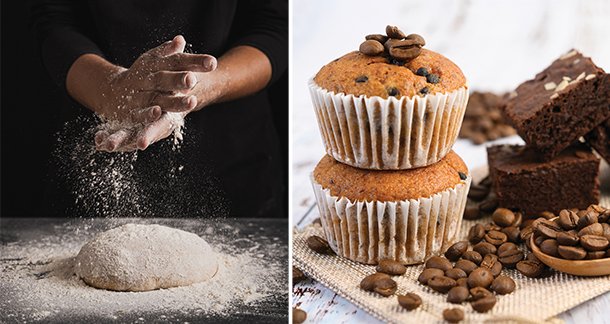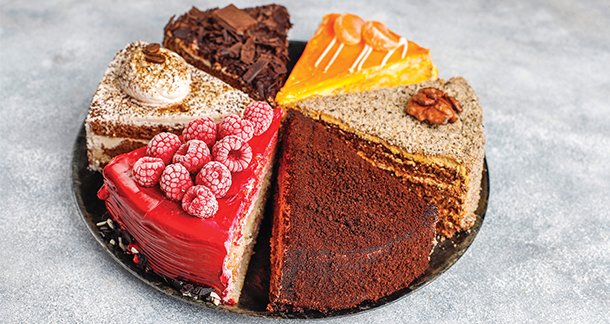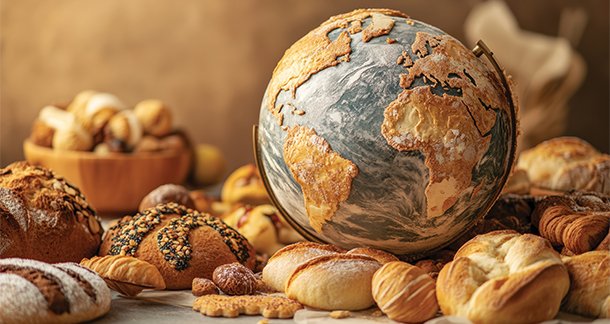regions due to cultural preferences, economic factors, and market dynamics. The bakery landscapes in the United States and India are quite distinct, shaped by consumer habits, per capita consumption, investment capacities, and the scale of operations.
The global bakery industry, valued at approximately USD 550–600 billion in 2024, plays a vital role in the food sector, driven by consumer demand for convenience, taste, and variety. While Europe and North America dominate the market, Asia-Pacific, including India, is witnessing rapid growth due to urbanization and changing lifestyles. The United States holds a significant 20–22% share of the global bakery market, valued at around USD 110–120 billion, with high per capita consumption of 45–50 kg per year. In contrast, India’s bakery market is valued at USD 10–12 billion, representing just 2–2.5% of the global market, with a much lower per capita consumption of 2–3 kg per year, primarily due to the dominance of traditional staples like roti and naan. Popular products in the USA include bread, bagels, muffins, cookies, and donuts, while India favours biscuits, rusk, bread, and eggless cakes, reflecting cultural preferences and affordability. As health trends and premiumization reshape the market, both countries present unique opportunities for innovation and growth in the bakery sector.
1. Bakery Production: Scale, Setup & Operations
USA: Large-Scale Automated Production & Fresh Bakery in Supermarkets
The United States bakery industry is dominated by large-scale, highly automated production facilities operated by major companies such as Bimbo Bakeries, Flowers Foods, and Pepperidge Farm. These industrial bakeries produce vast quantities of packaged bread, buns, muffins, and cookies for supermarkets, convenience stores, and food service industries.
- Supermarket In-Store Bakeries: Large grocery chains such as Walmart, Costco, and Whole Foods have dedicated in-store bakeries where fresh bread, cakes, and pastries are prepared daily.
- Frozen & Pre-Made Bakery Solutions: Many retail stores rely on frozen dough and par-baked products, which are baked fresh in-store to ensure consistency and minimize waste.
- Advanced Technology: Automated proofing, fermentation, and baking processes allow for mass production with longer shelf-life and consistency.

India: Cottage & Medium-Scale Bakery Industry
In contrast, India’s bakery industry is highly fragmented, with a mix of small-scale, cottage bakeries, traditional bakeries, and mid-sized commercial bakeries. The market is primarily price-sensitive, with consumers preferring fresh, affordable products.
- Cottage Bakeries: Many small bakeries operate at a neighbourhood level, producing fresh bread, cakes, and biscuits daily, catering to local demand.
- Medium-Scale Bakeries: Semi-automated setups in cities produce a variety of bakery products but struggle with high investment costs and low margins.
- Limited Large-Scale Automation: Unlike the USA, automation in India remains low due to capital constraints and consumer preference for fresh products.
- Handmade & Local Specialties: In many regions, handmade items such as khari biscuits, rusk, and traditional tea-time snacks dominate the market.
2. Consumer Preferences & Product Range
USA: High Demand for Packaged & Healthy Bakery Products
Bakery products are a staple part of the American diet, widely consumed at breakfast, lunch, and as snacks. The US market also places a strong emphasis on healthy, organic, and gluten-free options.
- Popular Bakery Items: Bread (white, whole wheat, sourdough), bagels, muffins, cookies, croissants, and pies.
- Health-Conscious Trends: Demand for gluten-free, keto, and whole grain bakery items is
- Premium & Artisan Products: High-end bakeries focus on artisan breads, European pastries, and sourdough fermentation techniques.
India: Preference for Fresh & Affordable Bakery Items
India’s bakery culture is less developed than the US due to the strong tradition of home-cooked meals, particularly roti, naan, and parathas, which act as competition to commercial bread. Bakery products are often seen as occasional indulgences or breakfast items rather than daily staples.
- Popular Bakery Items: Tea-time snacks like rusk, khari biscuits, cream rolls, and fruit cakes are widely consumed.
- Eggless & Vegetarian Bakery: Due to religious and cultural factors, eggless cakes and bakery items dominate the market.
- Handmade Roti vs. Bread: Many Indian households still prefer homemade chapati and paratha over mass-produced bread.

3. Investment & Return on Investment (ROI) Challenges USA: High Investment, High ROI Due to Strong Demand
- Industrial bakeries require significant capital investment in automation, ingredient sourcing, and supply chain logistics.
- Large-scale production ensures high margins through economies of scale and premium pricing for specialty bakery items.
India: Low ROI Due to Price Sensitivity
- Investment in bakery production is limited by low margins and price sensitivity.
- High production costs and consumer reluctance to pay premium prices make profitability a
- Most bakeries focus on low-cost, high-turnover items to stay
4. Growth Opportunities & Future Trends
USA: Expanding Healthy & Artisanal Bakery Markets
- Organic, gluten-free, and high-protein bakery items are gaining
- E-commerce and direct-to-consumer brands are reshaping bakery
- Sustainability and clean-label products are influencing consumer
India: Rising Urbanization & Changing Lifestyles Driving Demand
- Western-style bakery products (croissants, muffins, bagels) are growing in metro
- Premium bakery brands targeting urban consumers are
- The adoption of automation and frozen dough technology is slowly
Conclusion:
The gap between the U.S. and Indian bakery markets highlights both a challenge and an opportunity for India to transform its fragmented bakery landscape into a globally competitive market. While the U.S. enjoys a mature industry driven by advanced automation, premium products, and efficient supply chains, India, with only 2–2.5% of the global market share, is rapidly growing at a CAGR of 8–10%.
To bridge this gap, India must prioritize advanced automation, efficient production processes, and product innovation, with a focus on healthier, long-shelf-life items such as multigrain breads, tortillas, and fortified snacks. Strengthening cold chain logistics, expanding e-commerce channels, and enhancing rural market penetration will further accelerate growth. Collaboration between industry leaders, technology providers, and policymakers is essential to drive skill development, enhance quality standards, and promote sustainable practices.
With the right strategies, India’s bakery market is projected to reach USD 18–20 billion by 2030, positioning it as a key global player while meeting the evolving preferences of both domestic and international consumers.
About the Author
Dr L.S.CHANNA
Chana Integrated Bakery Solutions



